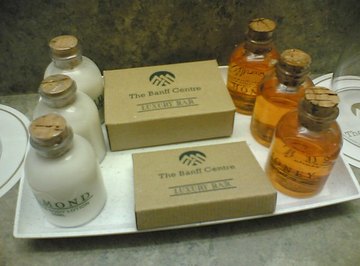
Dimethicone is a type of silicone, an organic polymer that is isolated to perform a specific task. Silicones often are used as moisturizing and lubricating agents and are common ingredients in commercial health or hygiene products. There are several different types of silicone, but they all have similar qualities.
Silicones
Silicone was created gradually as scientists began to discover the ways silicon bonds with various elements. The major breakthrough came when oxygen was bonded with silicon in a tetrahedronic structure where silicon stayed in the center and oxygen remained on the outside points. This allows scientists to chain the compounds together in a long polymer-like line. These chains are then attached to organic compounds, usually those of methyl groups. This combination tends to make silicones extremely resistant to water yet keeps them flexible and free-moving, ideal properties for a lubricant.
Whereas other types of polymers, such as plastics, are not commonly found in health and hygiene products, the flow properties of silicones lend them to such purposes. While silicones have few medical qualities themselves, they are used to transport more active ingredients. One of the most common kinds of silicone is dimethicone.
Dimethicone
The prefix "dimeth" refers to the two methyl groups that are attached to the silicone molecule, combining the compounds to form dimethicone. This is one of the least complicated variants of silicone and is used most often in hair care products. When applied to hair or skin, it tends to impart a sheen caused by the flow of the organic polymers.
Other Derivatives
In addition to dimethicone, other types of silicone include phenyl trimethicone, dimethicone copolyol and cyclomethicone. Phenyl trimethicone is highly water resistant and is used to trap water in skin or hair and add flexibility. Cyclomethicone is a more resistant variety of dimethicone that performs the same function, while dimethicone copolyol is a water-soluble version of the same.
Uses
Wherever natural oils are used, silicones can be used in their place. These synthetic oils tend to last longer and have more precise purposes, such as being able to protect hair and skin for longer periods of time. Lotions, shampoos and a variety of moisturizers use silicones for such purposes.
Safety
Critics say that dimethicone can be toxic to the human body because of the risk that the silicon molecules used to create it might be absorbed through the skin. According to Silicone Solutions, however, silicones are designed specifically to be inert and nontoxic. Their molecules are also generally too large to be absorbed into the skin, so they rarely, if ever, enter the body.
References
About the Author
Tyler Lacoma has worked as a writer and editor for several years after graduating from George Fox University with a degree in business management and writing/literature. He works on business and technology topics for clients such as Obsessable, EBSCO, Drop.io, The TAC Group, Anaxos, Dynamic Page Solutions and others, specializing in ecology, marketing and modern trends.
Photo Credits
Image by Flickr.com, courtesy of Roland Tanglao
